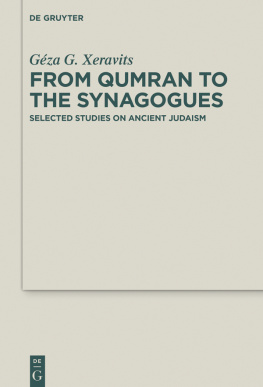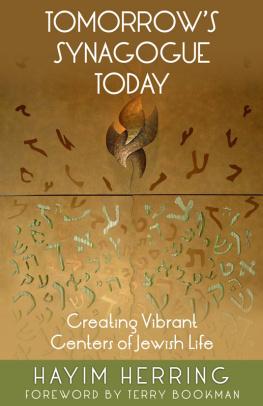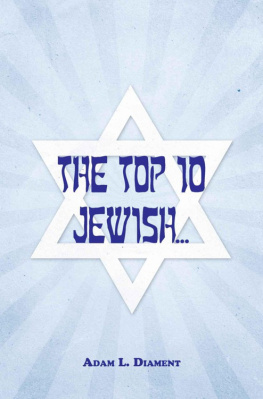
Acknowledgments
This volume has been developed under the joint aegis of The National Center for Jewish Policy Studies, and STAR (Synagogues: Transformation and Renewal).
As editor of Synagogues in a Time of Change: Fragmentation and Diversity in Jewish Religious Movements, I would like to acknowledge the cooperation of the many outstanding contributors to this volume whose thinking and writing have greatly enriched this discussion. I am particularly grateful to Dr. David M. Gordis, now president emeritus of Hebrew College and founding director of the National Center for Jewish Policy Studies, Rabbi Hayim Herring, Executive Director of STAR (Synagogues: Transformation and Renewal), and Rabbi Sanford Seltzer, Director of the Interreligious Center on Public Life and formerly Associate Dean of Hebrew College's Rabbinical School, who have placed their confidence in me and entrusted me with the development of this project. They have always been available for consultation, sharing their wise insights, and have functioned as an informal editorial advisory committee. The National Center for Jewish Policy Studies acknowledges its indebtedness to Hebrew College, Newton Centre, Massachusetts, of which it is an independent affiliate, for its continued hospitality and administrative support during the past fifteen years.
A special note of gratitude to Dr. Maury and Joyce Hoberman whose personal commitment to this project was expressed in their tangible support that helped make its development and editing possible. Their support is another expression of their desire to contribute to the creation of a vibrant Jewish community, rich in spirit and ideas.
Our appreciation is expressed to James Wind, Richard Bass, and Kristy Arnesen Pullen of the Alban Institute, who have understood the significance of this volume and have undertaken to bring it to print and distribute it to a wide readership. The editorial skills of Andrea Lee have been especially valuable in enhancing the precision of language and style of this text that is the product of so many hands.
CHAPTER 1
History as Prophecy
Narrating the American Synagogue
David B. Starr
The synagogue remains a central institution in Jewish life as a place of study, worship, and assembly. Those three activities remind students of Jewish life that since ancient times Jewishness contains some definite if imprecise admixture of ethnicity and religion, a worldview of rituals and values that generate behavior, belief, and modes of belonging. In the longue dure of diasporic post-Temple (70 CE) Jewry this spelled a rough but perceptible consensus about the boundaries and content of Jewish life, horizontally in relation to non-Jews; vertically in relation to a sense of Jewish history, destiny, and purposes.
Yet the centrality of the synagogue notwithstanding, its precise place in Jewish life varied throughout the ages. Many in the Jewish community may nostalgically pine for the lost world of traditional Jewish society, which involved a larger communal construct of governance structures, leaders, and institutionsa Jewish body politic in which the synagogue numbered as but one of many communal institutions. It shared the burden for Jewish life, since Jews practiced their rituals demarcating time and space as much if not more in the home and in the street as in any demarcated sancta. Even the notion of sancta hardly applied to the synagogue, since it contained no functioning priesthood, no cult of purity reminiscent of the ancient temple. Its leadersthe sagesdominated by their earned intellectual talents rather than any inherited prescribed ritual role. These sages worked with and competed against lay leaders, together with whom they led Jewish religious and social life.
Like any institution, the synagogue demands historical scrutiny since it never stands outside of its context: it reflects as much as it leads larger trends in Jewish and indeed general society. One has to look only at a nineteenth-century German Reform temple to see Lutheran influences; the family pews of twentieth-century North American non-Orthodox temples and synagogues to see the hand of trends in gender, family, and religion.
Much of the best history writing on the United States began with the time-honored notion of U.S. exceptionalism. But rather than blithely assuming and asserting that as fact, many scholars now linger over this notion, asking and critiquing that if the United States has been different, how so? This approach suits Jewish historical study to a tee, since that method always demands that history be considered in twin contexts: that of its locale and of placing any given place and time within the sweep of the Jewish historical story. After all, it is fair to ask whether a synagogue in my hometown of Brookline, Massachusetts, or any U.S. synagogue resembles more its non-Jewish house of worship that stands down the street than it does a synagogue that existed there in 1920, or a synagogue in Salonika in 1935 or 1535?
The Synagogue in Twin Contexts
Haym Soloveitchik has written about evolution in modern Orthodoxy in the second half of the twentieth century. His work suggested that synagogues become part of larger trends occurring in Jewish life. In Orthodoxy this included the decline of organic communities that relied upon tradition and custom, which gave way to enclaves of tighter, more doctrinaire and rigid approaches to learning and to life. Orthodox synagogues have benefited from this swing to the right by increasing lay rigor; yet the rabbis of those synagogues may feel pressure from laity desiring even more fixity than the rabbi may deem correct or advisable.
Soloveitchik's work incorporates understanding of both the Jewish and U.S. dimensions of his story. A student of Jacob Katz, he knows that Orthodoxy exists as a modern traditionalist ideological construct, not to be equated with a traditional society. He knows that it responded to various shifts that affected modern Jewry, like the nineteenth-century Emancipation movement and the Jewish Enlightenment in Europe, migration, and acculturation. He charts the ways in which internal cultural production like rabbinic legal texts reflected these shifts by compensating for the decline of traditional society. New assertions of codificatory power emerged at the expense of the local, the customary, the mimetic dimension of traditional praxis.
He recognizes that this trend reflects the twentieth-century North American world as well: the world of the university, the progressive emphasis on the rational and the expert, the linear teaching that the technology of books and the Internet delivers, all of which tend to flatten out the textures of the traditional society. Add to that the socioeconomic upward mobility of modern Orthodoxy, and the modern Orthodox synagogue comes into view: as posh as liberal synagogues, yet filled with young families desiring greater observance and commitment to Orthodox educational institutions like yeshivot, at the same time seeking the Ivy League acceptance letter for their children.1
American synagogue study reflects a classic tension within the study of American religious history. This may be termed a clash between the declinists versus transformationalists (perhaps the latter incorporates a revival-decline dynamic). Perry Miller, the great historian of the Puritans, may be seen as an exponent of the decline school. He read the Puritans as tragic figures, unable or unwilling to cope with the challenge that social change posed to their Calvinist religious worldview. Their errand into the wilderness, as the seventeenth-century minister Samuel Danforth described it, gave way to the commercial revolution that transformed that wilderness into America, from a periphery of empire to an emerging country in its own right, from Puritans to Yankees. In this scheme religion lost, defeated by capitalism's power and its own inability to respond adequately. Puritan declension, symbolized by their acceptance of the halfway covenant rather than the full covenant liberalizing who could be considered as saved, came too late to salvage their religious project of building religiously ordered community.2
Next page





